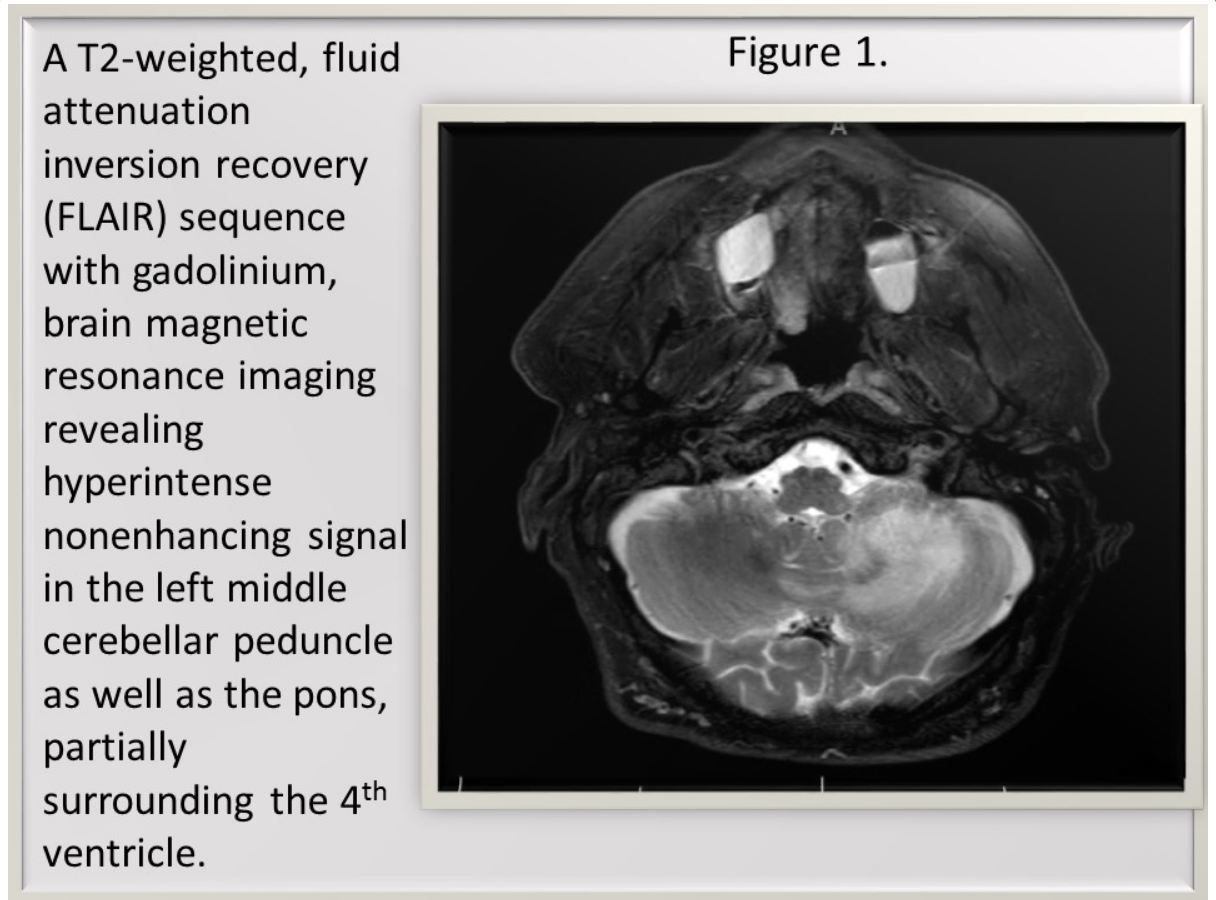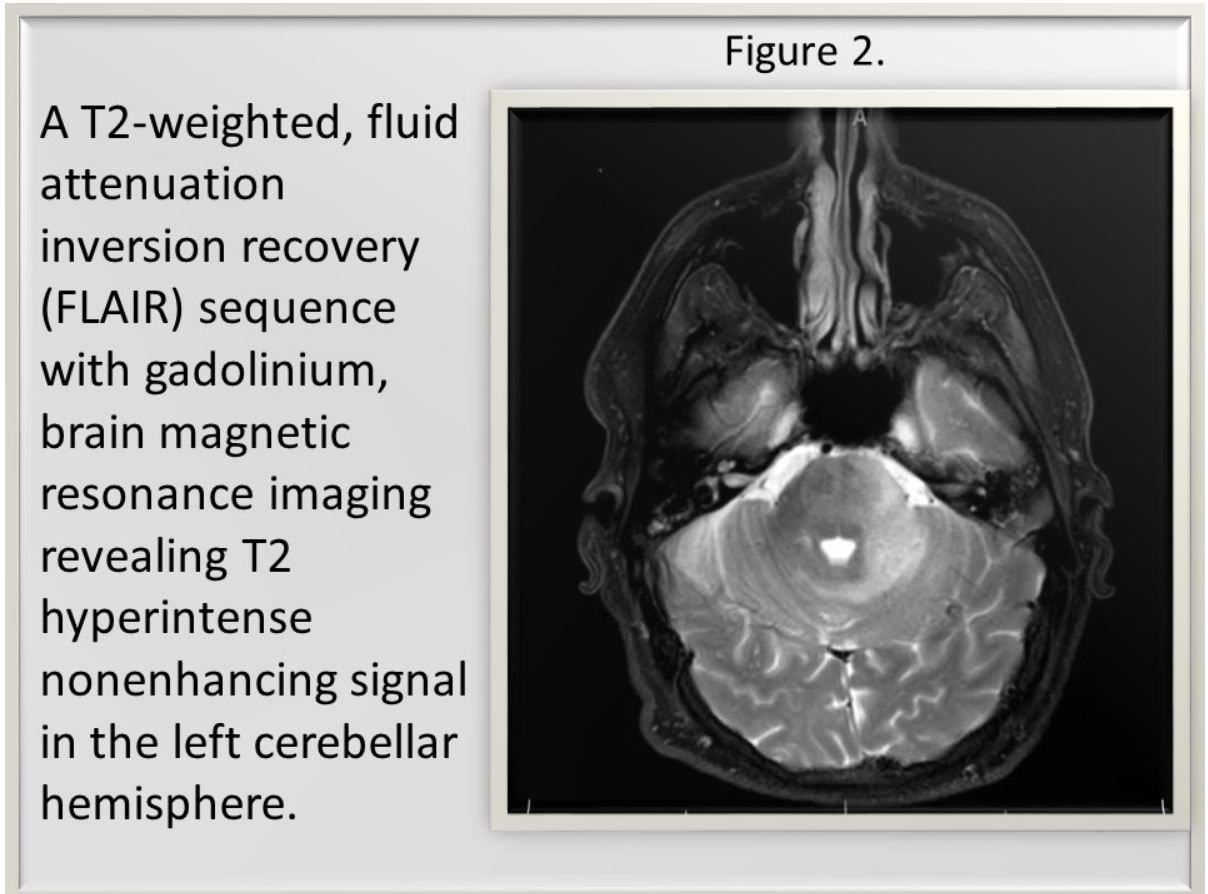Progressive Multifocal Leukoencephalopathy in a Man with Long-Standing HIV
Here’s a case in point about progressive multifocal leukoencephalopathy in a patient with long-standing HIV who had never taken HART.
Figure 1

Figure 2

Dr. Wilner’s latest book, Bullets and Brains, is a collection of over 100 essays that focus on the intersection of neurology and society. You can follow him on Twitter: @drwilner.
Case Report
A 39-year-old man with HIV diagnosed 14 years ago presented with 3 weeks of ataxia and slurred speech. He had never taken highly active retroviral therapy (HART) for HIV, believing that herbs and vitamins were effective treatment.
Neurological examination revealed slowed cognition, bilateral nystagmus, fluent but dysarthric speech, and left sided dysmetria with finger-to-nose and heel-to-shin testing. Total white blood cell count was 4,130 per microliter, but CD4 T cell count was only 75 cells/cubic millimeter (normal >500) with an HIV viral load of 446,000 (normal=nondetectable).
MRI scans showed a nonenhancing lesion restricted to the posterior fossa (Figures 1 and 2).
Figure 1
Figure 2
Hospital course
The patient received HART for HIV as well as trimethoprim/sulfamethoxazole (Bactrim) for presumed cerebral toxoplasmosis. Despite treatment, the lesion continued to enlarge. Results of a lumbar puncture included a polymerase chain reaction (PCR) negative for Toxoplasma gondii. However, PCR was positive for both the John Cunningham (JC) virus and Epstein Barr (EB) virus.
The presence of JC virus suggested the possibility of progressive multifocal leukoencephalopathy (PML), while the presence of EB virus raised the possibility of primary CNS lymphoma. Absence of gadolinium enhancement on MRI1 and negative CSF cytology weighed against CNS lymphoma. A brain biopsy was considered to make a definitive diagnosis, but neurosurgery deemed it too hazardous. As there is no specific treatment for PML, the patient was encouraged to remain on HART medications to improve his immune response. He did not receive chemotherapy or radiotherapy.
The patient was discharged to a rehabilitation hospital but continued to decline with increased dysarthria, dysphagia and respiratory distress. He was admitted to the intensive care unit and intubated.
His neurological deterioration continued with decreased movement of his extremities and altered mental status. Repeat MRI demonstrated more brainstem involvement as well as lesion progression to the left thalamus. Steroid treatment for possible immune reconstitution inflammatory syndrome was ineffective. He died 5 weeks after presentation. The family refused an autopsy.
Discussion
Progressive multifocal leukoencephalopathy is a rare viral disease of the CNS most often seen in immunocompromised patients with HIV.2 Patients with hematological malignancies and those with multiple sclerosis treated with natalizumab (Tysabri) represent two other groups at high-risk for PML.
Definitive PML diagnosis requires neuropathological demonstration of demyelination, bizarre astrocytes, and enlarged oligodendroglial nuclei in the presence of JC virus.3 MRI typically shows hyperintense T2 weighted and fluid-attenuated inversion recovery (FLAIR) images, as in this patient. Gadolinium enhancement only occurs in up to 15% of cases of HIV-associated PML.3 Isolated posterior fossa PML has been reported.3
Other than reconstitution of the immune system, PML has no treatment. The outcome for most patients with PML is poor.4
KEY POINTS
. Progressive multifocal leukoencephalopathy should be considered in immunocompromised patients with isolated posterior fossa lesions.
. The presence of JC virus in the CSF along with consistent clinical and neuroimaging findings supports the diagnosis of PML.
. Prognosis for patients with PML is poor.5
References:
1. Haldorsen IS, Espeland L, Larsson EM. Central nervous system lymphoma: Characteristic findings on traditional and advanced imaging. AJNR. 2011;32:984-992.
2. Engsig FN, Hansen ABE, Omland LH et al. Incidence, clinical presentation, and outcome of progressive multifocal leukoencephalopathy in HIV-infected patients during the highly active antiretroviral therapy era: A nationwide cohort. J Infect Dis. 2009;199:77-83.
3. Berger JR, Aksamit AJ, Clifford DB et al. PML diagnostic criteria: consensus statement from the AAN Neuroinfectious Disease Section. Neurology. 2013;80:1430-1438.
4. Schubert RD, Richie MB. Human immunodeficiency virus presenting as progressive multifocal leukoencephalopathy restricted to the posterior fossa. JAMA Neurology. March 27, 2017, doi:10.1001/jamaneurol.2017.9985.
5. Pavlovic D, Patera AC, Nyberg F, et al. Progressive multifocal leukoencephalopathy: current treatment options and future perspectives. Ther Adv Neurol Disord. 2015;8:255-273.
IDWeek 2023: New Data Provide Closer Look at Real-World Utilization of Cabotegravir for HIV PrEP
October 15th 2023IDWeek 2023. New study found just slightly more than half of prescriptions for cabotegravir for HIV PrEP resulted in at least 1 injection, suggesting limitations in use and access to the injectable HIV integrase inhibitor.
Common Side Effects of Antiretroviral Therapy in HIV Infection
February 7th 2013What are some of the more common side effects of antiretroviral therapy, and what can the primary care physician do to help manage these effects? In this podcast, infectious disease expert Rodger MacArthur, MD, offers insights and points readers to updated comprehensive guidelines.